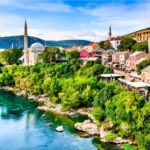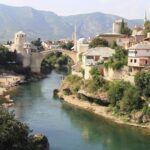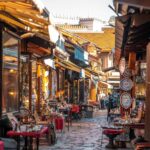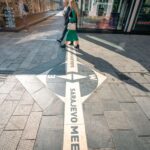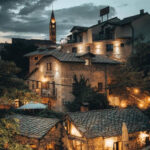Many people in the United States, including many of us in the class initially, have never heard of Bosnia and Herzegovina!
You may ask why BiH was chosen as the country to travel to and analyze its culture. The answer is simple: for centuries, BiH has been the center of where cultures collide.
Here are lists of facts that we learned on our trip from locals on why this is true:
Ethnic demographics
- Bosnia and Herzegovina consists of three ethnic groups: Bosnians, Croats, and Serbs.
- Following the first fact, Bosnia and Herzegovina speak three languages: Bosnian, Croatian, and Serbian.
- These three languages are taught in school, meaning that Bosnian children are taught two scripts: Latin and Cyrillic.
Government
- Bosnia has three presidents, each representing each ethnic group in Bosnia
- The government of Bosnia is split between two highly autonomous entities, the Bosnian Serb Republic and the Federation of Bosnia and Herzegovina.
Religion
- Bosnians have peacefully coexisted with each other while practicing different religions, including Catholicism, Bosnian Christianity, Orthodox Christianity, Judaism, and Islam.
- Now, the country is split evenly between Islam and Christianity, with Catholic and Orthodox churches ruling the sects of Christianity. There are ~1000 mosques, ~1000 Catholic churches, and ~1000 Orthodox churches in BiH
- Regardless of religion, Bosnians have been looking out for each other for a long time. There are two significant examples of this: first, Zejneba Hardaga, a Muslim woman, protected her Jewish neighbors during Nazi occupation by covering their Star of David with her hijab whenever they needed to go out. She was one of 44 BiH people awarded Righteous Among the Nations. When the Bosnian war broke out in 1992, her neighbor’s daughters raised enough money to fly her out to Israel. Second, the Sarajevo Haggadah, a significant religious book in Judaism, was hidden by a museum worker from a Nazi worker and given to his brother, a Muslim Imam, to keep the book safe. Now over seven hundred years old, this book survived for visitors to visit in the National Museum of BiH.
Around the City
- At Sarajevo’s old town, a marking on the ground says “Sarajevo meeting of cultures” with two cardinal directions: east and west. In the east, you can see four centuries’ worth of mosques, schools, fountains, and other significant buildings of the Ottoman Empire. In the east, you can see the Austro-Hungarian architecture fitted with two churches and public squares. When Archduke Franz Ferdinand bought BiH from the Ottoman Empire, he respected the established Ottoman society and decided to start his new age in Sarajevo from the western area onwards.
- Speaking of Archduke Franz Ferdinand, on one side of the Latin Bridge, you can see the footprints of where nineteen-year-old Gavril Princip shot the Archduke and his wife, Sophie. When on trial and asked why he shot a woman, he answered, “I didn’t shoot a woman. I shot a symbol of oppression.”
- In the public square near the two churches on the western side of the old town, a statue of a man pulling the meridians of the globe together with doves was gifted by the government of Italy. The statue symbolizes how Bosnians have always tried to connect different regions of the world.
History
- Hotel Holiday, the hotel we stayed at during our trip, was where the Olympians of the 1984 Winter Olympics resided. These Olympics were significant for two reasons: they marked the dissolution of tensions between the U.S. and Russia as it was the first Olympics where they met in a former Soviet state in Central Europe, and they are a significant example of how all Bosnians came together to connect the world. You can still find many Olympic rings around the city today.
- Many remnants of the 1992 Bosnian War can be seen all over the city today. Red resin fills concrete holes left by bombings of civilians. Many buildings still have markings of arm damage. Coppersmiths in the old town converted bullet casings into pens, whistles, flower pots, and other beautiful objects. Museums throughout the city tell the stories of millions of Bosnians during the war.
- Sarajevo was one of two cities in the world (the other being Havana) to be visited by the Pope twice in the last twenty years. The first was to showcase to the world the unique coexistence of regions in Sarajevo, and the second was to condemn the war.
